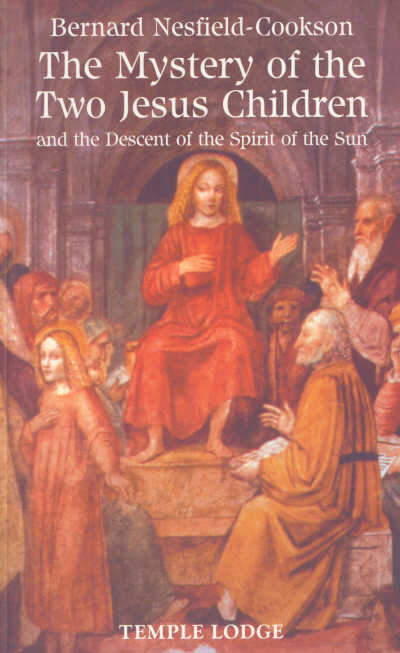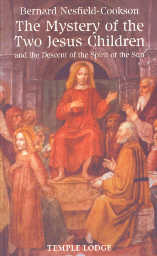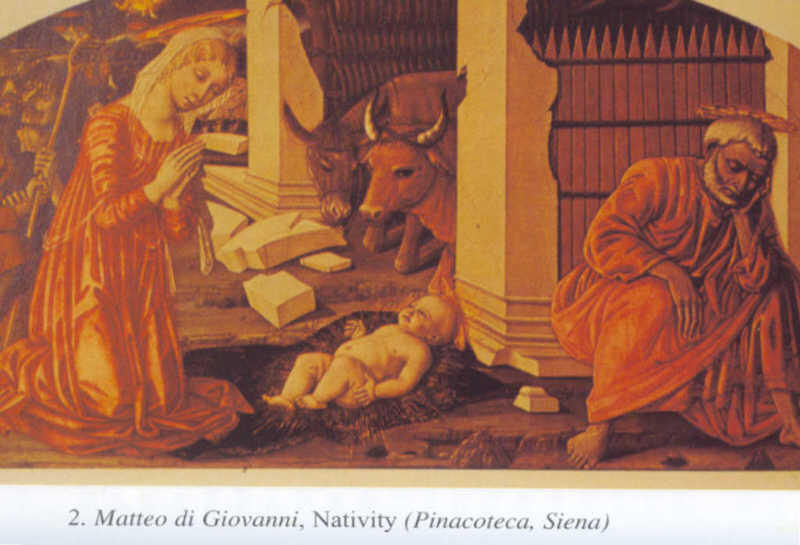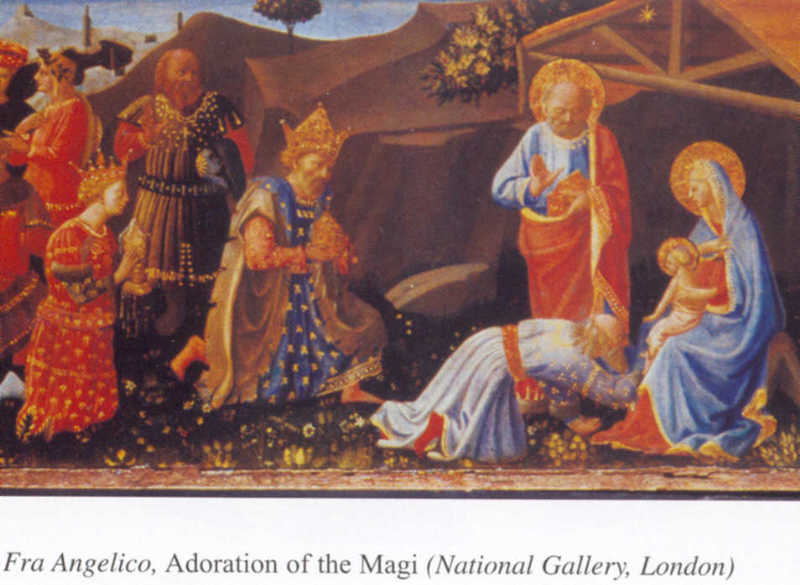The Luke Mary led a hidden life in the small hamlet of Nazareth while the Matthew Mary
led an open life in the cosmopolitan city of the time, Jerusalem. She was taken to the
temple there by her parents when she was only three years old where she, a
precocious young girl, was taught and grew in wisdom for about ten years. (Pages 9,
10) One can easily interpret "precocious" as an indication of an old soul.
[page 10] Early on, the Mary of the Gospel of Matthew manifested as an 'old
soul [. . .] she represents the polar opposite to the young Mary of the Gospel
of Luke'.
The author also reveals that the "ass" as a beast of burden represented the physical body of the
human being whose task is to carry our higher human natures (soul and spirit) during our Earth
existence. The image of Christ Jesus entering the holy city of Jerusalem riding on an ass represents the
human body of Jesus carrying the Christ Spirit within it like the body of the ass is carrying a human
being upon its back. These two levels of understanding had been intermixed in prophecies for
hundreds of years before the event occurred in the time of Christ Jesus.
[page 11] Rudolf Frieling reminds us, moreover, that the ass was always the
symbol of the human physical nature, whose task it is to carry the human
being's higher natures on earth. St Francis of Assisi called his body 'Brother
ass'. The prophet Zechariah foretells that the Messiah will come riding on an
ass (Zechariah 9:9), meaning that he would descend into the realm of
corporeality. According to the Gospel of Matthew, Christ entered the holy city
of Jerusalem riding on an ass (Matthew 21:5).
In the Matthew Gospel, an angel appears to Joseph, the father of Jesus, whereas in the Luke
Gospel, an angel appears to Mary. In Matthew the angel appears to tell Joseph to take his family to
Egypt to escape Herod's persecution.
In Luke the angel appears to tell Mary that her cousin is pregnant with a son. Mary, already
pregnant herself, visits Elizabeth who greets her, telling Mary that she is twice blessed, one by the pre-Fall "male etheric body withheld from Eve" which had entered into Mary and two by pre-Fall virginal
female etheric body withheld from Adam which was inside the Jesus baby in her womb.(1) It was this
pre-Fall etheric body which made Mary a virgin, and gave to her the name Blessed Virgin for all time.
Elizabeth's deed gave us the lines from ubiquitous Catholic prayer, the Hail Mary, "Blessed are Thou
among women, and Blessed is the fruit of Thy Womb, Jesus." Elizabeth was acknowledging what she
could see directly with her ancient clairvoyance in her old age, the two pre-Fall etheric bodies which
formed her cousin Mary's body.
[page 12] We then learn that the baby leapt for joy in Elisabeth's womb at the
sound of Mary's greeting. What we see here is John the Baptist's
instantaneous recognition of the significance of the child in Mary's womb.
This momentous event — not mentioned by Matthew — foreshadows
what was to take place 30 years later in the River Jordan, when John baptizes
and recognizes Christ. He it is of whom John the Baptist has already declared:
'I indeed have baptized you with water, but he shall baptize you with the Holy
Ghost' (Luke 3:16). In Matthew's Gospel we hear that when Jesus comes to
John to be baptized, the Baptist exclaims that he rather needs to be baptized
by Jesus Christ (3:13-14).
To understand rightly the event known as the Mystery of Golgotha, how Christ came to the
Earth, entered the body of Jesus of Nazareth, and died on the cross, one must understand that the
Great Spirit — the one we have come to call Christ and have appended that name to Jesus, either as
Christ Jesus or Jesus Christ — had been known for hundreds and thousands of years before Jesus
was born, and that Christ Spirit had been approaching the Earth and had been worshiped from the
beginning of human times. None other St. Augustine, the great church father himself, spoke of this as
fact.
[page 40] It has been mentioned already that in the early years of the
twentieth century Rudolf Steiner spoke on many occasions of Christ as the
Spirit of the Sun, and that over a long period of time this Spirit gradually
descended out of the cosmic heights to incarnate in a physical body. For
instance, he indicated this in a lecture in 1911. He quoted the following few
words of St Augustine: 'That which we now call the Christian religion already
existed among the ancients and was never absent from the beginning of the
human race up to the time when Christ appeared in the flesh; from that time
forward the true religion, which was already there, received the name of the
Christian religion.'
Essential to the Christ Spirit's appearing on Earth in the flesh were the Nathan and Solomon
Jesus children. One was filled with grace and the other with the wisdom of the Magi.
[page 47] Luke, in his Gospel, speaks of this child as being 'filled with wisdom
and the grace of God was upon him. One could, perhaps, say that it was the
kind of wisdom with which a person is endowed, who lives and works in
harmonious communion with nature, a person who does not intellectually
probe and analyze, but 'knows' with the forces of his heart. Thus in the Nathan
Jesus we see a child with infinite depths of feeling, wisdom of the heart.
In contrast to the Nathan child we could say that the Solomon Jesus
child possessed the wisdom of the Magi, of the Three Wise Men from the
East. 'He was an individuality of exceptional maturity, having profound
understanding of the world, wisdom of the head.
In a miraculous event in the Temple in Jerusalem, there would emerge one child, the Nathan
Jesus who would later receive the Christ Spirit during his Baptism by John in the Jordan.
[page 51] Steiner describes how, in the temple in Jerusalem, the Nathan Jesus
child, all soul and heart, received into himself the spirit and thinking power of
the Solomon Jesus child. As a consequence of this Mystery event, the
Solomon child was depleted of his life-forces and died shortly after it had
taken place. The Nathan Jesus, on the other hand, was now so wise that the
learned men in the temple 'were amazed at his intelligence and the answers he
gave' to their questions (Luke 2:47).94 The keenest capacities of wisdom of
the head, of the brain, such as only a descendant of the house of Solomon
could develop, were united with the purest love forces of the heart of the
Nathan Child. The kingly and the priestly powers were united in the Nathan
Jesus child and formed the chalice into which, 18 years later, at the Baptism
by John in the River Jordan, the Christ Being descended or, as Luke
describes this moment, 'the heaven was opened, and the Holy Ghost
descended in a bodily shape like a dove upon him, and a voice came from
heaven, which said, Thou art my beloved Son; in thee I am well pleased' (Luke
3:22).
This three-day event in the Temple can be seen as an early initiation event for the Nathan Jesus
during which his future mission is revealed to him.
[page 51, 52] The twelve-year-old Nathan Jesus became aware of his future
mission on earth during the three days in the temple. We remember that in
answer to his mother's troubled questioning when he was found in the temple
he answered her, according to Luke, with two questions: 'How is it that ye
sought me? wist ye not that I must be about my Father's business?' His true
Father, the twelve-year-old is saying, is not Joseph but God. He was already
aware of the reality of the divine message which would issue from the
heavenly heights at this baptism.
The perfected human who was to become the earthen vessel of the Christ Spirit would have to
combine the wisdom and reverence of the Magi with the humility and piety of the shepherds. The Two
Jesus children would have to become One in the Temple, "and qualities that had been entirely inward
[would become] outward." (Page 53) The process by which the two become one was first described
by Rudolf Steiner in 1909 and is illustrated in the cover art of this book. It is from a painting by
Bergognone which "shows Mary leading a second Jesus boy away, even while the twelve-year-old
Nathan Jesus boy is still speaking from the podium." (Page 65) Why should we believe these are two
Jesus boys? The author gives us a threefold reason.
[page 65] First, Bergognone is not representing continuity within a story by
depicting two or more actions of one and the same person, for the convention
of continuous representation requires that actions that are separated
chronologically must also be given their individual, separated spaces.
Bergognone has not complied with this requirement. Indeed, as Ovason(2)
points out, 'the device of continuous representation was outmoded by
Bergognone's time'. Second, although the two boys resemble each other in
appearance, they are not the same. The boy on the left of the picture, upon
whom Mary is gazing down with loving concern, appears depleted of energy.
We notice that both are clothed in red shifts. However, the shift of the boy
leaving the temple is paler in colour than that of the twelve-year-old seated in
the center. Both are making similar gestures, though those of the departing
Jesus boy are much weaker; his left arm is not held up and outwards but, palm
downwards, hanging limply towards the ground. This weakened gesture is
reflected in his face. In comparison with the Jesus boy in the chair of the
teacher, the departing boy appears wan and ailing. We notice, too, that the
halo of this boy, the Solomon Jesus, is far less brilliant than that of the
teaching Nathan Jesus. And, thirdly, the two Jesus boys are clearly aware of
each other. In particular, we can recognize the bond between the two boys by
the way in which the Nathan Jesus looks down upon the departing Solomon
Jesus with what Ovason calls 'a strange mixture of love and wistfulness'(3)

Rudolf Steiner gave his indications of the reality of the two Jesus children before any of the
substantiating evidence found in the Dead Sea Scrolls and other apocryphal scriptures. He saw the
events with his own native clairvoyance and his descriptions simply add details and veracity to the
artworks of the Renaissance and other scriptures unearthed since Steiner's time.
[page 65, 66] He [Ovason] goes on to say: 'The Solomon child seems to have
sacrificed something of his spirit, something of his being to the Nathan child,
and consequently is suffering.' According to Steiner the Solomon Jesus died
very shortly after this event in the temple. It is clear that it is not solely the
Nathan boy who is aware of his departing friend, for nearly all, if not all those
learned men who a moment before had been discoursing with the twelve-year-old on the podium, now have their attention directed towards the boy who is
about to leave the temple with Mary and Joseph.
None of these descriptions, paintings, or scriptures can convince you that there were two Jesus
children — it is a conclusion you only arrive at by carefully considering all the evidence as indicating a
deeper reality than is commonly accepted by established historians, so-called experts of Christian
artworks, and Church dogma as revealed to the public.
[page 68] We have seen that the
idea of two Jesus children, spoken
about by Rudolf Steiner as early as
1909, is supported in some of the
Christian apocryphal gospels, in
Gnostic texts and, above all, in
some of the Dead Sea Scrolls first
discovered at Qumran. We have
also seen that there was present a
line of Essene secret teaching which
continued within Christian circles
and that a tradition of the existence
of two Jesus children prevailed in
Christian art up to the Renaissance.
There is therefore some
justification in seriously suggesting
an affirmative answer to the
question 'Were there two Jesus
children?' — the one spoken of in
Matthew's Gospel the other in that
of Luke.
"Were there two Jesus children?" can only have a personal answer to anyone studying the matter
objectively and with spiritual insight. Simply saying, "Oh, that's foolish!" is not an answer to the
question of whether there were two Jesus children as much as it is an expression of one's ignorance
and willingness to remain ignorant on the matter. If you insist on rejecting the idea of two Jesus
children, you will be in good company with the majority of the people in the world and that thought
may be comforting, but you will be left with the unanswered questions posed by the dramatic
discrepancies in the Gospels of Matthew and Luke. If you cavalierly ignore these differences you will
have throw out one of the two Jesus babies with your bath water of indifference.
~^~
---------------------------- Footnotes -----------------------------------------
Footnote 1.
I quote here from Edward Reaugh Smith's book, The Incredible Births of Jesus.
Return to text directly before Footnote 1.
~~~~~~~~~~~~~~~~~~~~~~~~~~~~~~~~~~~~~~~~~~~~~~
Footnote 2.
See David Ovason's The Two Jesus Children here: http://www.doyletics.com/arj/twochild.htm
Return to text directly before Footnote 2.
~~~~~~~~~~~~~~~~~~~~~~~~~~~~~~~~~~~~~~~~~~~~~~
Footnote 3.
See Rudolf Steiner's Lectures in Christ and the Spiritual World, GA#149 here: http://www.doyletics.com/arj/christsw.shtml He relates how the Nathan Jesus-child's spirit was instrumental in all four sacrifices of Christ, three of them preceding the events described in the Bible.
Return to text directly before Footnote 3.
~~~~~~~~~~~~~~~~~~~~~~~~~~~~~~~~~~~~~~~~~~~~~~
~^~
Any questions about this review, Contact: Bobby Matherne
~~~~~~~~~~~~~~~~~~~~~~~~~~~~~~~~~~~~~~~~~~~~~~~~~~~~~~~~~~

 == == == == == == == == == == == == == == == ==
== == == == == == == == == == == == == == == ==
22+ Million Good Readers have Liked Us
22,454,155
as of November 7, 2019
Mo-to-Date Daily Ave 5,528
Readers
For Monthly DIGESTWORLD Email Reminder:
Subscribe! You'll Like Us, Too!
== == == == == == == == == == == == == == == ==
Click Left Photo for List of All ARJ2 Reviews Click Right Bookcover for Next Review in List
Did you Enjoy this Webpage?
Subscribe to the Good Mountain Press Digest: Click Here!


CLICK ON FLAGS TO OPEN OUR FIRST-AID KIT.
All the tools you need for a simple Speed Trace IN ONE PLACE. Do you feel like you're swimming against a strong current in your life? Are you fearful? Are you seeing red? Very angry? Anxious? Feel down or upset by everyday occurrences? Plagued by chronic discomforts like migraine headaches? Have seasickness on cruises? Have butterflies when you get up to speak? Learn to use this simple 21st Century memory technique. Remove these unwanted physical body states, and even more, without surgery, drugs, or psychotherapy, and best of all: without charge to you.
Simply CLICK AND OPEN the
FIRST-AID KIT.

Counselor? Visit the Counselor's Corner for Suggestions on Incorporating Doyletics in Your Work.

All material on this webpage Copyright 2019 by Bobby Matherne
![Click to return to ARJ Page, File Photo of Bernard Nesfield-Cookson]](http://www.doyletics.com/arj/twomyaut.jpg)







